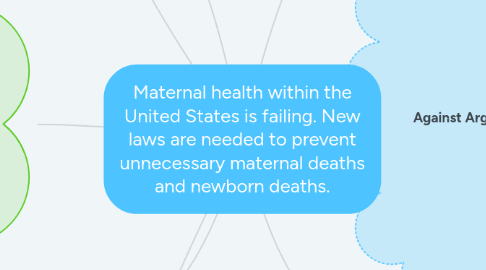
1. Preventing Maternal Deaths Act of 2018. This law provided the CDC additional funding to monitor maternal deaths within each state and within tribal regions (Preventing Maternal Deaths Act of 2018).
2. Maternal Health Accountability Act of 2017. This law allocated funding to the Department of Health and Human Services to mandate reporting of deaths of women during pregnancy and 1 year postpartum (Maternal Health Accountability Act of 2017).
3. Stakeholder
3.1. Hospitals and Medical Clinics
4. Stakeholder
4.1. Families
5. Pro Argument
5.1. Despite being a global leader in healthcare the United States ranks one of the lowest in developed countries in both maternal deaths and infant deaths (Amnesty International, 2011)
5.1.1. Approximately three in five pregnancy-related deaths were preventable (Barfield et al, 2017)
5.1.2. The leading causes of death varies by time. During pregnancy, other noncardiovascular and other cardiovascular conditions were the leading causes of death. On the day of delivery, hemorrhage and amniotic fluid embolism were the major causes of death. Hemorrhage, hypertensive disorders of pregnancy, and infection were leading causes of death during the first 6 days postpartum. From 6 weeks postpartum (43 days) through the end of the first year (365 days), cardiomyopathy was the leading cause of death (Amnesty International, 2011)
5.1.3. Maternal mortality in the US has worsened, falling from 41st to 50th in the world (Amnesty International, 2011)
6. Stakeholder -
6.1. Women who are pregnant, planning to be pregnant or who are within the "fourth trimester"
7. Stakeholder-
7.1. Medical Professionals including doctors, nurses and medical assistants
8. Against Argument
8.1. New policies are not needed to focus on infant and maternal health.
8.1.1. Legislation should be focused on addressing health care disparities as these are the leading indicators of infant/maternal death
8.1.1.1. 42% of maternal death are within the African American community. 32% within the Native American Community.(MacDorman, M. et at, 2010)
8.1.1.2. 45% of maternal/infant deaths are women who have a high school education or lower (MacDorman, M. et at, 2010)
8.1.1.3. Significant racial/ ethnic disparities in pregnancy-related mortality exist; black women have a pregnancy-related mortality ratio approximately three times as high as that of white women (MacDorman, M. et at, 2010)
8.1.1.4. Most maternal death are related to postpartum care. 21.4% on days 7–42 postpartum, and 11.7% on days 43–365 postpartum. (MacDorman, M. et at, 2010)

